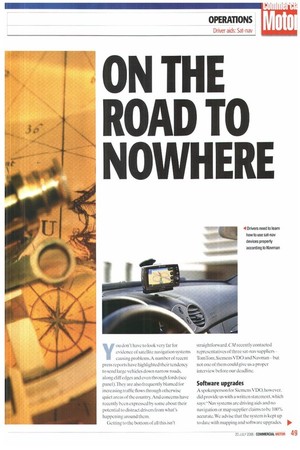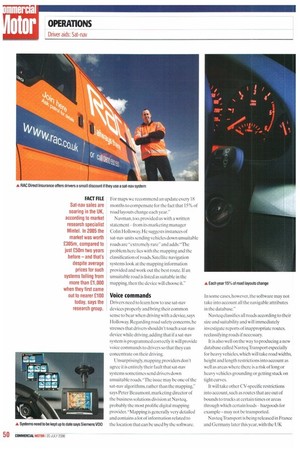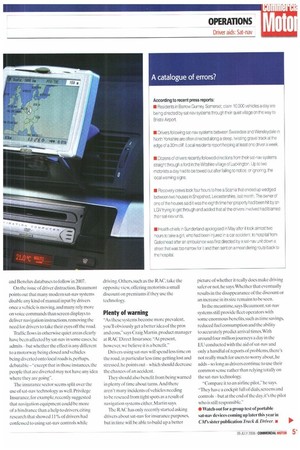ON THE ROAD TO NOWHERE
Page 49

Page 50

Page 51

If you've noticed an error in this article please click here to report it so we can fix it.
ou don't have to look very far for evidence of satellite navigation systems causing problems.A number of recent press reports have highlighted their tendency to send large vehicles down narrow roads, along cliff edges and even through fords (see panel).They are also frequently blamed for increasing traffic flows through otherwise quiet areas of the country. And concerns have recently been expressed by some about their potential to distract drivers from what's happening around them.
Getting to the bottom of all this isn't straightforward. CM recently contacted representatives of three sat-nav suppliersTomTom,Siemens VDO and Navman — but not one of them could give us a proper interview before our deadline.
Software upgrades
A spokesperson for Siemens VDO, however, did provide us with a written statement, which says:"Nav systems are driving aids and no navigation or map supplier claims to be .100% accura Le. We advise that the system is kept up to date with mapping and software upgrades. For maps we recommend an update every 18 months to compensate for the fact that 15% of road layouts change each year."
Navman, too, provided us with a written statement-from its marketing manager Colin Holloway. He suggests instances of sat-nay units sending vehicles down unsuitable roads are "extremely rare" and adds: "The problem here lies with the mapping and the classification of roads. Satellite navigation systems look at the mapping information provided and work out the best route. If an unsuitable road is listed as suitable in the mapping, then the device will choose it."
Voice commands
Drivers need to learn how to use sat-nay devices properly and bring their common sense to bear when driving with a device, says Holloway. Regarding road safety concerns, he stresses that drivers shouldn't touch a sat-nay device while driving, adding that if a sat-nay system is programmed correctly it will provide voice commands to drivers so that they can concentrate on their driving.
Unsurprisingly, mapping providers don't agree it is entirely their fault that sat-nav systems sometimes send drivers down unsuitable roads. "The issue may be one of the sat-nay algorithms, rather than the mapping," says Peter Beaumont, marketing director of the business solutions division at Navteq, probably the most prolific digital mapping provider.-Mapping is generally very detailed and contains a lot of information related to the location that can be used by the software. In some cases, however, the software may not take into account all the navigable attributes in the database."
Navtey classifies all roads according to their size and suitability and will immediately investigate reports of inappropriate routes, reclassifying roads if necessary It is also well on the way to producing a new database called Navteq Transport especially for heavy vehicles, which will take road widths, height and length restrictions into account as well as areas where there is a risk of long or heavy vehicles grounding or getting stuck on tight curves.
It will take other CV-specific restrictions into account, such as routes that are out of bounds to trucks at certain times or areas through which certain loads hazgoods for example -may not be transported.
Navteq Transport is being released in France and Germany later this year, with the UK and Benelux databases to follow in 2007.
On the issue of driver distraction, Beaumont points out that many modern sat-nay systems disable any kind of manual input by drivers once a vehicle is moving, and many rely more on voice commands than screen displays to deliver navigation instructions, removing the need for drivers to take their eyes off the road.
Traffic flows in otherwise quiet areas clearly have been affected by sat-nay in some cases, he admits but whether the effect is any different to a motorway being closed and vehicles being diverted onto local roads is, perhaps, debatable -"except that in those instances, the people that are diverted may not have any idea where they are going".
The insurance sector seems split over the use of sat-nay technology as well. Privilege Insurance, for example, recently suggested that navigation equipment could be more of a hindrance than a help to drivers, citing research that showed 11% of drivers had confessed to using sat-nay controls while driving.Others,such as the RAC, take the opposite view, offering motorists a small discount on premiums if they use the technology.
Plenty of warning "As these systems become more prevalent, you'll obviously get a better idea of the pros and eons," says Craig Martin, product manager at RAC Direct Insurance."At present, however, we believe it is a benefit."
Drivers using sat-nay will spend less time on the road, in particular less time getting lost and stressed. he points out-which should decrease the chances of an accident.
They should also benefit from being warned in plenty of time about turns. And there aren't many incidents of vehicles needing to be rescued from tight spots as a result of navigation systems either, Martin says.
The RAC has only recently started asking drivers about sat-nay for insurance purposes, but in time will be able to build up a better picture of whether it really does make driving safer or not, he says. Whether that eventually results in the disappearance of the discount or an increase in its size remains to be seen.
In the meantime, says Beaumont, sat-nav systems still provide fleet operators with some enormous benefits, such as time savings, reduced fuel consumption and the ability to accurately predict arrival times. With around four million journeys a day in the EU conducted with the aid of sat-nay and only a handful of reports of problems, there's not really much for users to worry about, he adds-so long as drivers continue to use their common sense rather than relying totally on the sat-nay technology.
"Compare it to an airline pilot," he says. -They have a cockpit full of dials, screens and controls-but at the end of the day, it's the pilot who is still responsible."
• Watch out for a group test of portable sat-nay doices coming up later this year in CM's sister publication Truck & Driver. •
























































































































































































